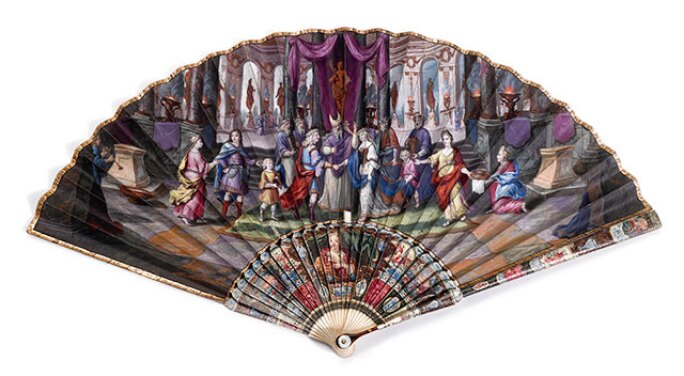Nowadays, it is widely believed that in Victorian times fans were used – much like gloves or parasols – for relaying secret messages. Drawing the fan across the cheek supposedly meant ‘I love you’, while twirling it in the left hand signalised ‘We are watched’ and dropping it was a suggestion to just be friends.
Whilst it seems reasonable that a Victorian lady could have used her fan not only as an accessory, but also as a tool to attract additional attention through affectionate gestures, it is perhaps doubtful that her male counterpart could have mastered this secret language, said to have consisted of about two dozen different moves or gestures.
Seeking to demystify this secret code, Duvelleroy, a fan maker and retailer founded in Paris in 1827, published a leaflet explaining the language behind the uses of the fan. In reality, the less romantic truth is that this so-called fan etiquette was invented in order to boost the sale of fans in the 19th century, after they had fallen out of fashion following the French Revolution. The leaflet proved a great success and Duvelleroy became a supplier for Queen Victoria, having opened a boutique on London’s fashionable New Bond Street.

The myth of this secret language is certainly a persistent one, prominently referred to in many later works of fiction, including Oscar Wilde’s 1892 play Lady Windermere’s Fan. The eponymous fan appears at key moments throughout the plot of both the original work and its modern adaptation A Good Woman, starring Scarlett Johansson as Lady Windermere.

However, Joseph Addison’s comment in the Spectator on 27 June 1711, that ‘women are armed with fans, as men are with swords’, must be understood as a satirical one – the ‘business of fans’ as such did not exist, but was rather an exaggeration of the fact that a society lady in the 18th century was expected to know how to elegantly handle and hold a fan, allowing observers to differentiate between different social statuses.
Interestingly though, some fans were used as a different form of communication. Similar to the opulent objects created by goldsmiths and silversmiths in the 17th-century to be used in drinking games at various European courts, the fan was an integral part of a popular 18th-century party game called ‘Fanology’ or ‘Speaking fan’. These fans were printed with questions and answers on either side and also gave examples of how to hold a conversation at a party by just using signs and gestures.
Naturally, this is only one of the many uses and functions of the fan. It was originally developed in Ancient Egypt, China and India a few thousand years ago, fulfilling both a ceremonial function and as a method for cooling oneself and keeping away insects. From around 1600, the hand-held fan was used in Europe, where it also gained the notion of a utensil for coquetry. Later on, fans were also used as commemorating special or historic events, such as weddings and coronations, the first hot air balloon flight of the De Montgolfière brothers in 1783 or for the French Revolution. Others were destined to entertain, such as the fortune-telling fan or those depicting mythological scenes.














